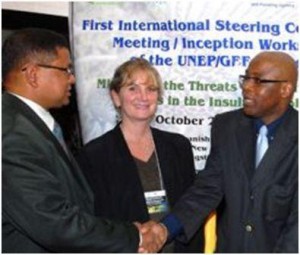
Chief Executive Officer (CEO) of the National Environment and Planning Agency (NEPA), Peter Knight, (left) speaks with Project Manager for the 'Mitigating the Threats of Invasive Alien Species (IAS) in the Insular Caribbean' project, Naitram Ramnanan, prior to its official launch on Wednesday in Kingston
Published on Monday, November 2, 2009 in CaribbeanNetNews
.
KINGSTON, Jamaica (JIS) — Jamaica is slated to benefit from a $154,769,042 (US$1,738,798) project to reduce the threat of invasive alien species (IAS) to the region’s biodiversity.
The project titled: ‘Mitigating the Threats of Invasive Alien Species in the Insular Caribbean’ is being funded by the United Nations Environment Programme’s Global Environment Facility (UNEP-GEF), and was officially launched on Wednesday in Kingston. The Centre for Agriculture and Biosciences International (CABI), a not-for-profit international organisation, is co-ordinating the project, while the National Environment and Planning Agency (NEPA) is the local implementing agency.
The four-year initiative, which will impact five countries, aims to strengthen national capacity, and facilitate the development of regional strategies to deal with alien species. The other countries are Trinidad and Tobago, St Lucia, Dominican Republic, and the Bahamas.
Chief Executive Officer (CEO) of NEPA, Peter Knight, in his remarks at the launch, said that the project is “very important project” especially as Jamaica and other Caribbean countries deal with the threat of lionfish, which is one of the most venomous and voracious predators in the ocean.
IAS expert at CABI, Arne Witt, said that the damage caused by invasive species is as much as $1.4 trillion per year, which is about five per cent of global Gross Development Product (GDP). The issue, he said, is not only one of bio-diversity, as IAS also impact food security, human health and economic development.
“In my experience in Africa, people are literally starving because of Invasive Alien Species, Witt stated, warning that if something is not done to control these species, “we are going to be in serious trouble.”
Task Manager for UNEP, Kristin McLaughlin, in noting the economic impact of IAS, stated that in the United States alone, “the cost of invasive species impacts, together with the control and prevention measures that we are currently instituting, $100 billion a year.”
“We know that economic costs are enormous and what’s scarier is that we can’t even quantify them (IAS) at this point. They are much, much bigger than we think they are and they are probably accelerating, unfortunately,” she said.
She emphasised that prevention measures are very important for Caribbean countries, which are largely dependent on tourism, agriculture, and fisheries.
According to a CABI fact sheet, invasive species are plants, animals or micro-organisms not native to an ecosystem, whose introduction is threatening biodiversity, food security, health or economic development.
The project being introduced in the Caribbean will assist the target countries to develop their own national strategies, which will inform coherent policies, legislation, regulation and management of invasive species. So far, the Bahamas is the only partner country, which already has a national invasive species strategy.
In addition, regional consultations will be held on marine, terrestrial and freshwater aquatic IAS, which will provide the basis for a co-operative Caribbean-wide strategy.
Based on a critical situation analysis for each country, best practice guidelines will be drawn up and these, as well as findings from all research work, will be made available to build capacity in order to eradicate, and improve control and management of invasive species and to prevent new invasions.
In addition to participation in the development of national and regional strategies, each country will also address its own most pressing problems. This will be achieved through 12 pilot projects relating to prevention, early detection and rapid response, management, and eradication of the most problematic invasive species.
These projects include the management of the lionfish in Jamaica and the Bahamas; protection of endangered and endemic reptiles on Maria Island, St Lucia; action against a suspected invasion of threatening native sea grass beds in Trinidad & Tobago; and eradication of invasive predatory mammals threatening endangered native birds and reptiles in St Lucia and the Dominican Republic.
Two further pilot projects will develop management strategies for sites of high conservation value, which are threatened by invasive species, namely: the Lower Black River Morass in Jamaica; and the Nariva Swamp in Trinidad and Tobago, where rare and endangered palm species are threatened by exotic insect pests.

Chief Executive Officer (CEO) of the National Environment and Planning Agency (NEPA), Peter Knight, (left) speaks with Project Manager for the 'Mitigating the Threats of Invasive Alien Species (IAS) in the Insular Caribbean' project, Naitram Ramnanan, prior to its official launch on Wednesday in Kingston
Some of the other IAS species found in Jamaica, include the wild ginger, water hyacinth, which is a water weed and the Australian red claw lobster that has now invaded the Black River in St Elizabeth.